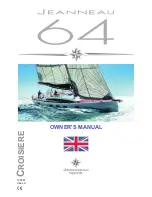
BASIC KAYAK FEATURES
The front of the boat is the bow and the rear is the stern.
When looking forward to the bow, the left side of the boat is
Port and the right side is Starboard. The hull ID number can
be found on the bottom of the boat, at the stern.
In the middle of the boat, there is a cockpit area, with the seat
(toward the stern) and footwells (toward the bow). Inside the
cockpit are scupper hole(s) that go all the way through the
boat. These scuppers allow the boat to drain. Your particular
model may have hatches that allow access to the inside of
the boat for gear storage.
Alongside the cockpit are a series -of small “U” straps, called
pad eyes. These are used to attach accessories such as
backrests.
All Hobie kayaks are made of linear polyethylene, making
them repairable and recyclable.
SAFETY
Paddlesports / pedaling can be dangerous and physically
demanding. The user of this product should understand that
participating in paddlesports may involve serious injury or
death. Observe the following safety standards when using
this product. These are basic safety rules that all boaters
should follow. Always use common sense and follow all
safety rules at all times.
• To avoid damage to the Mirage Drive, push either pedal
completely forward before beaching or in shallow water.
Use small, partial, pedal strokes with one pedal nearly all
the way forward until there is adequate water depth for the
Mirage Drive to have complete clearance in the water.
• Consult your physician prior to beginning
paddlesport / pedaling training.
• Carry a spare paddle.
• Obtain paddlesport/pedaling instructions from your dealer
specific to this type of craft.
• Obtain certified first aid training and carry first aid and
rescue/safety equipment.
• Always wear a nationally approved personal flotation
device.
• Wear a helmet where appropriate.
• Dress appropriately for weather conditions; cold water
and/or weather can result in hypothermia.
• Check your equipment prior to each use for signs of wear
or failure.
• Never pedal or paddle alone.
• Always use a leash tied to your paddle.
• Do not pedal or paddle in flood conditions.
• Be aware of appropriate river water levels, tidal changes,
dangerous currents, obstacles in and above the water and
weather changes.
• Scout unfamiliar waters; portage where appropriate.
• Do not exceed your paddling/pedaling ability; be aware of
your limitations.
• DO NOT use alcohol or mind-altering drugs prior to or while
using this product.
• Follow the manufacturer’s recommendations for use of this
product.
• If additional outfitting is added to this craft, use
manufacturer-approved materials only; do not impair entry
or exit access.
• Read owner’s information package prior to using this
product.
The user of this product acknowledges both an
understanding and assumption of the risk involved in
paddlesports/pedaling.
Beware of offshore winds that may make it difficult to return
to shore.
When paddling in a new area, check with the locals regarding
currents, shoreline conditions and weather patterns. Plan an
“escape route” -- an alternative place to get off the water
should environmental conditions dictate.
Hobie Kayaks were not designed for fast moving water.
HOW TO PERFORM A SELF RESCUE
If you fall out of your boat, don’t panic. Stay with the boat. You
should be wearing a life jacket which will keep you afloat.
There are many ways to get back up on the boat.
If the boat is upside down, it will need to be turned over. To
do this, reach across the bottom of the boat and grab the
scupper hole or Mirage Drive and pull the boat upright.
Position yourself so your head is near the cockpit area of the
boat and you are facing the boat. You will also want to be
between the seat and the footwell areas of the boat.
Reach across the boat to the far edge with one hand. Place
the other hand on the near side rail, then kick with your feet,
pulling yourself up and onto the boat, so your bellybutton is
across the center line of the boat. (Your belly should end up
between the footwells and the seat.)
Next, roll over onto your backside toward the seat, which
should place your backside in the seat. Sit up, swing your feet
into the footwells and you’re ready to go.
The key to this, and any method, is to keep your center of
gravity low and near the centerline of the boat. Your body and
head should stay close to the boat.
CAUTION: While righting the Hobie Mirage or climbing back
aboard, stay clear of the pedals, pedal shafts and sails. Be
careful not to get hit by them or get them hooked into your life
jacket. Also be aware of the seat adjustment straps.
5



























